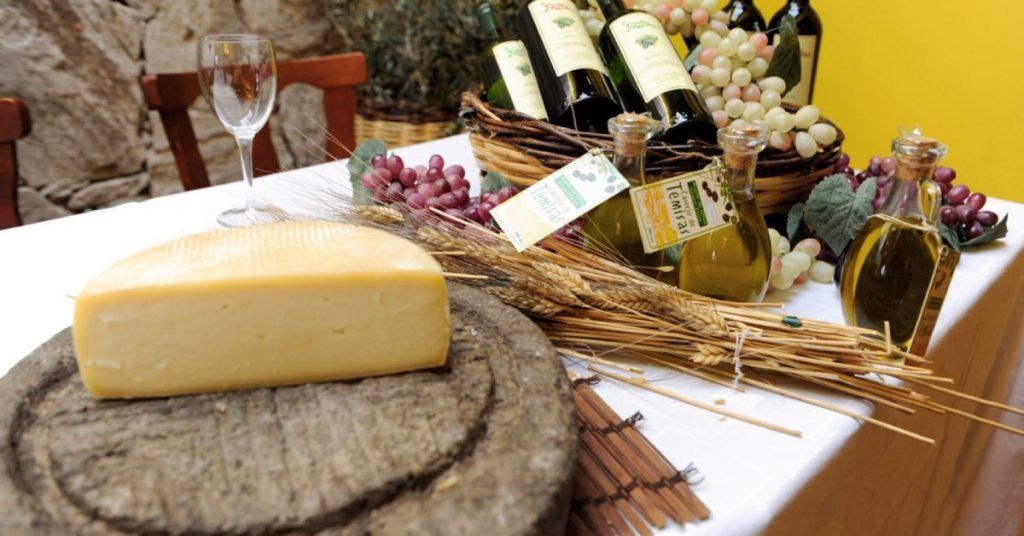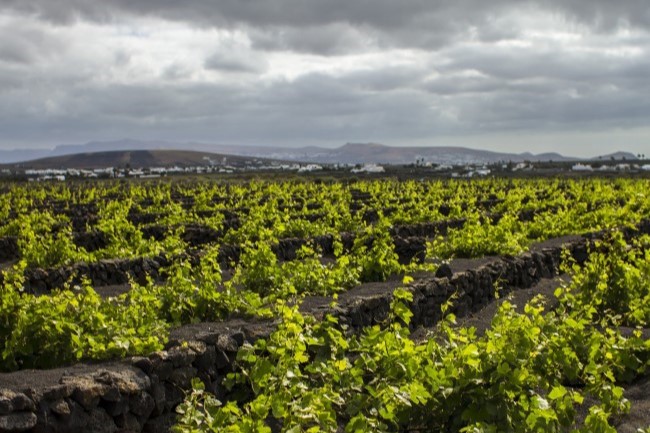
If you like the world of wine and want to taste the incredible wines of the island, then we suggest to do the Lanzarote wine tour and visit some of the wineries at La Geria.
Besides its volcanic landscapes and beautiful beaches, the island of Lanzarote is known worldwide for its wine production. The climate and soil of the island define the characteristics of its agriculture, and its wines have a taste that is as unique and different as Lanzarote itself.

Lanzarote produces many white, rosé and red wines, but there is one specific grape variety that stands out above the rest: the volcanic Malvasía, highly regarded among wine lovers for its balance and quality. This grape produces a very aromatic white wine, mostly sweet, but it can also be dry.

Vineyards of Lanzarote
Despite the endemic scarcity of rain, due to its proximity to warm Africa, the island offers all of the conditions for viticulture, a miracle that is due in equal measure to the tireless work of winegrowers and the benefits of the trade winds bringing moisture from the Atlantic over its tormented geography. Viticulture in Lanzarote is one of the clearest examples of this dramatic fight between man and environment.

Holes in the volcanic ash layer
Farmers dig holes in the shape of a funnel in the volcanic ash layer until they reach the topsoil and at the bottom of these holes, which are sometimes over two meters deep, they plant one to three vines per hole and build semicircular walls of rock about 60-70 cm high to protect these holes from the constant winds. Each wall protects the vines from being covered with volcanic ash. In areas where the lapilli layer is smaller (Tinajo, Masdache, Yé-Lajares), these semicircular walls are built to protect the vines from the wind.

The wine route in La Geria, Lanzarote, is the most famous wine route of the island, perhaps of the whole Canary Islands archipelago, and a must for wine and gastronomy lovers.
Characteristics of vine cultivation on Lanzarote
The uniqueness of vine growing in Lanzarote is conditioned by the characteristics of the soil, which has given rise to two forms of cultivation:
- The hole system, which can be seen especially in La Geria, and which gives rise to a landscape of great beauty.
- Farmer digs holes in the layer of lapilli to gain access to the topsoil where he plants the vines, and builds stone walls in a semicircular shape to protect them from the wind.
- The trench system, here the stone walls are linear, so the planting density is higher. This form of cultivation does not allow the use of machinery, so work is carried out manually, and also makes the use of high planting densities impossible, with the low yield that this entails, obtaining low but quality productions.
- The average age of the vines is between 30 and 50 years
- Type of harvest: It is carried out without any mechanization, taking the greatest care possible. Healthy batches of grapes are used to make the protected wines. Harvesting is carried out in line with the absorption capacity of the wineries to avoid any deterioration in quality.

Designation of Origin Regulatory Council
The production area of this Designation of Origin extends through many towns across the island, making up three main winegrowing areas:
- La Geria: : The vineyard zone is located between the towns of Yaiza and Tías. The sand cover is natural up to 5 meters deep, as a result of volcanic eruptions
- Masdache: This is the largest area and there are two different subareas: Tinajo, where the diversion ditch crop pattern is used, and Masdache itself with its extensive vineyards.
- Ye-Lajares: Area between the towns of Haría and Teguise. This is an area with low productivity given the type of soil. This is the only place in the world using this planting distance. The harvest is the earliest, as the grape harvest begins in July. The must finishes fermenting when the Beaujolais (ostensibly the earliest wine in Europe) is still on the vine.

Types of Grapes
The grape varieties used to produce the excellent wines from Lanzarote are: Malvasia, Listán Blanco, Moscatel, Diego, Burra Blanca, Breval, Pedro Ximénez, Listán Negro, and Negramoll. The vine, mainly the Malvasia, is perfectly adapted to the environment and produces a small grape with a limited yield, but great quality due to its balance, taste, and scent that is later transferred to the wine. We shouldn’t forget the Diego grape, a variety that ripens late and makes very aromatic wines.

The majority of the harvest goes toward the production of white wines, be them dry, semi-dry, semi-sweet, sweet, liqueur wines, crianzas, and sparkling, although not only should the region’s rosés be mentioned, but also its high-quality reds. Its young white wines are straw yellow and very aromatic, and the personality the Malvasia lends it is notable. Pleasant on the palate, balanced, and with a dry almond finish.

The rosés are pink – redcurrant, fresh, fruity, and lingering. The reds are generally medium-depth, warm, and have good structure. Liqueur wines prepared with Moscatel grapes are very generous, aromatic, and of excellent quality for dessert or as an aperitif.
The yield by hectare has a bad track record; it varies between 1,000 and 1,500 kg. Production on the island is subject to climatic whims, with production varying between one and three million kilos.
Lanzarote best wineries

Rubicón
Bodegas Rubicón is one of the most popular wineries in Lanzarote. Located in La Geria, on the road from Teguise to Yaiza, 2. Rubicón is a winery that hosts wine tasting events, and it’s also home to a restaurant, and a souvenir and wine shop.
Bodegas Rubicón sits over an old country house from the 15th century, and produces wines with the Lanzarote certificate of origin, guaranteeing its quality and authenticity. You may visit the winery and the old house on your own or as part of a guided tour. Inside the old country house, guests can visit the room where the traditional treading of grapes took place years ago, and a large cistern.

Another interesting thing to keep in mind is the beautiful scene you can contemplate from its restaurant: an eucalyptus garden, with Timanfaya as the background, just spectacular! You may visit this three-centuries-old winery every day, from 10 in the morning to 8 in the evening.

Bermejo
Los Bermejos is another charming bodega that you can visit on the wine route in Lanzarote. It is located on the Finca Los Bermejos, on the slopes of the volcano named after one of the most famous members of the founding family, “Juan Bello”. The bodega offers typical Lanzarote wines, with the characteristic flavour provided by the volcanic soil and mild temperatures. Its wines are single varietals such as dry malvasia, semi-sweet malvasia, sweet malvasia, dry diego or sweet muscatel or coupages such as carbonic maceration red, barrel-aged red or rosé, depending on the maximum expression they can achieve.

Malpais de Maguez. “La Grieta”
Bodega Malpais de Maguez, after many years of agricultural tradition and especially the vineyard, presents in 2007 its wine “La Grieta”, produced in the new facilities of the winery. It has 15 hectares of vineyards in the north of the island, where most of them are over 500 metres high. The vineyards are free-standing, made up of old European vines that have best adapted to the climate of Lanzarote.
Most of the vineyards are made up of hundred-year-old vines, with low yields and long, gentle maturation, contributing to the quality of our wines. The Malpaís de Máguez winery is located at sea level and less than one hundred and fifty metres from the coast. Its wines are fermented, decanted and rested in tanks at the cooing of the Atlantic waves. Finally they are bottled and distributed in the market.
Guiguan Winery
Bodegas Guiguan is a traditional wine cellar that still has small family wineries, with data that brings us closer to the knowledge of the way of cultivating the vine and the system of wine production, a way of life then.
Vega de Yuco
Bodegas Vega de Yuco is a family business that started its activity in 1997.
It is located on a hill covered with vines in the village of Masdache, in a low traffic area where the Malvasía Volcánica grape predominates. In 2005, with the creation of the Yaiza brand, it underwent one of its most important changes. The blue bottle, with its particular shape, became the winery’s flagship.
Stratvs
Bodega Stratvs Located in Barranco del Obispo, next to the Timanfaya National Park. In its surroundings, strains of frank foot are cultivated, with more than 150 years of antiquity, in the gerias, name that comes from the characteristic holes excavated like cradle to the island cultures.

It has the most modern equipment, thus allowing to extract the best from the grapes and to produce prestigious wines with personality, as the numerous awards obtained show. It has a room where courses and tastings are given, a library specialised in the world of wine and a gourmet shop.
La Querencia
A quieter winery than its more famous counterparts, Bodega La Querencia is another place to visit in La Geria, near Timanfaya National Park, that is part of the wine route in Lanzarote. Open from 11 in the morning to 6 in the evening, its visitors can eat some tapas and drink the local wine while they contemplate the lovely vistas to the volcanic landscape of the island.
La Florida
In San Bartolomé, east from Timanfaya National Park, we reach Bodega La Florida, an iconic location and another great example of what you will find if you do the wine route in Lanzarote. Its origins go back to the first half of the 19th century, a period in time when many other wineries were established in Lanzarote as well.

The main building in the estate is typical of traditional architecture of Lanzarote, with a surrounding garden worthy of contemplation: a well-stocked garden of canarian native plants and a large 270-year-old drago tree, one of the older living dragos in the Canary Islands.
El Grifo
San Bartolomé, in the heart of the island, is where Bodegas el Grifo is located. Another key location of the wine route in Lanzarote, this winery has been producing wine since the late 18th century, making it one of the oldest wineries in Spain.
This family winery’s vineyard is harvested by hand and produces half a million wine bottles per year with a Lanzarote certificate of origin.
La Geria
Another winery you can’t miss in Lanzarote is Bodegas La Geria. Its history goes back to the 19th century, when it was founded on top of the ashes left by La Corona eruption. Nowadays, it’s malvasía grape that grows from that volcanic soil to be transformed into the famous wine of Lanzarote.
La Geria is also one of the most visited wineries in all Spain: it welcomes more than 300,000 guests every year.
Lanzarote Wine Tour
La Geria is the most famous wine region on the Canary Islands, being a must-see for those who love the world of wine and gastronomy. Below is a map of the wineries on Lanzarote in case you would like to do the wine tour on your own.

Lanzarote is an ideal place to enjoy food and wine holidays and discover its special way of growing grapes, which are unique in the world.
We, at Lanzarote Experience Tours offer a wine tour or if your wish you can book a place in our Timanfaya and the Fire Mountains Experience Tour, where we stop at La Geria, the wine district.
Do you have any questions ?
Please, send us an email info@lanzaroteexperiencetours.com , or WhatsApp +34 646080585
Trust us and join us in our tours
You won´t regret it !

